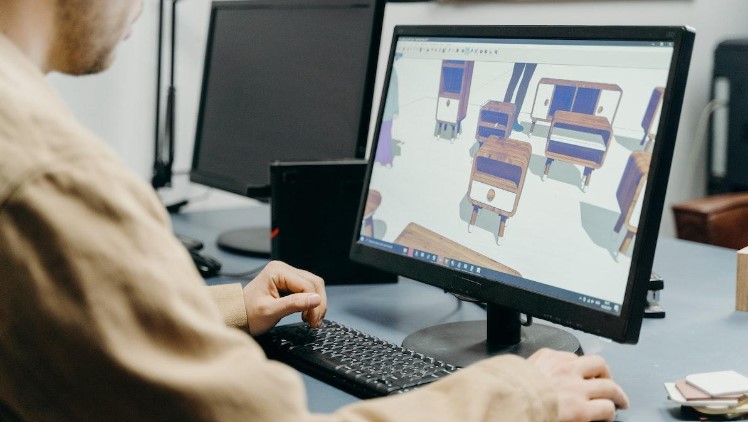Table of Contents
Introduction
In the realm of interior design, where artistry and functionality converge, creating spaces that resonate with depth and character requires a certain touch of magic. This magic often lies in the meticulous interplay of textures and materials. Every surface, every fabric, and every element contributes to the narrative of a space, telling a story that is both tactile and visual. In this blog, we delve into the art of weaving texture and material into interior design, exploring how a diploma in interior designing can unlock doors to endless possibilities. Moreover, we will uncover the advantages of being an interior designer, shedding light on the multifaceted journey of these creative minds.
The Power of Texture and Material in Interior Design
Texture and material are the silent storytellers of interior spaces. They add depth, dimension, and a tangible sense of character to a room. The soft plushness of a velvet couch, the cool smoothness of marble floors, the intricate patterns of woven rugs – each element speaks a unique language that contributes to the overall aesthetic. The juxtaposition of various textures can evoke a range of emotions, from comfort and warmth to modern sleekness.
Textures go beyond the visual – they beckon to be touched, felt, and experienced. This interaction with the environment engages our senses, forging a deeper connection to the space we inhabit. Interior designers wield these textures like artists, carefully curating an environment that not only looks stunning but feels inviting.
Elevating Spaces with Diplomas in Interior Designing
A diploma in interior designing can be a pivotal step towards mastering the art of texture and material manipulation. Through comprehensive courses, aspiring designers delve into the world of design principles, spatial arrangements, and the technical aspects of material selection. This education equips them with the skills to not only envision but also execute captivating designs that celebrate texture.
Interior design programs offer insights into the diverse array of materials available – from natural wood and stone to cutting-edge synthetics. Understanding the properties and potentials of these materials is essential for crafting harmonious spaces. Moreover, a diploma program provides hands-on experiences, allowing students to experiment with textures and observe their impact firsthand.
Advantages of Being an Interior Designer: Unveiling the Creative Journey
The advantages of being an interior designer extend far beyond the creative realm. Yes, the opportunity to shape captivating spaces is exhilarating, but the journey offers much more. Interior designers become problem solvers, space optimizers, and even psychologists of sorts, deciphering the unspoken needs of clients and translating them into tangible designs.
The autonomy that comes with being an interior designer is a significant advantage. The ability to give life to one’s vision, to handpick textures that resonate with the design narrative, and to witness a space transform under one’s expertise is immensely gratifying. Moreover, the field offers a blend of challenges and triumphs, keeping the creative spirit alive and thriving.
Weaving Texture and Material into Design: Practical Tips
Harmonious Pairing: The key to successful texture play lies in harmony. Combine rough with smooth, matte with glossy. For instance, a sleek glass tabletop can be perfectly complemented by a textured jute runner.
Consider the Mood: Texture can influence the mood of a space. Play with contrasts – plush fabrics for cosy nooks and sleek metals for contemporary areas.
Layering for Depth: Layering textures creates a sense of depth. A velvety throw over a leather sofa or a statement wall adorned with textured panels can add visual intrigue.
Light and Texture Dance: Lighting can accentuate texture. Experiment with light angles to cast intriguing shadows on textured surfaces, enhancing the tactile experience.
From Ordinary to Extraordinary: Case Studies
Let’s delve into a couple of case studies to witness the transformative power of textures and materials. In a suburban home redesign, the introduction of reclaimed wood panelling transformed a plain living room into a rustic haven. The tactile quality of the wood brought a sense of warmth and history to the space, instantly making it more inviting.
In a modern office setting, the strategic use of glass partitions with frosted textures offered privacy while maintaining an open feel. This play on transparency and texture not only served a functional purpose but also contributed to the overall aesthetic.
The Enduring Allure of Texture and Material
As design trends evolve, the enduring allure of texture and material remains constant. It’s the art of fusing the old with the new, the soft with the hard, and the intricate with the minimalistic that keeps interior design eternally captivating. A diploma in interior designing opens doors to this enchanting realm, allowing designers to craft experiences that transcend the visual.
Conclusion
In the symphony of interior design, texture and material compose the melody that resonates deeply with inhabitants and visitors alike. The tactile sensations and visual cues brought forth by these elements create spaces that are not just visually pleasing but emotionally engaging. Aspiring designers who embark on the journey through a diploma in interior designing are equipped with the knowledge and skills to orchestrate this symphony, while embracing the advantages of being an interior designer that extend beyond the surface. So, let’s celebrate the magic of texture and material, where every surface becomes a canvas and every element whispers a tale of character and charm.


